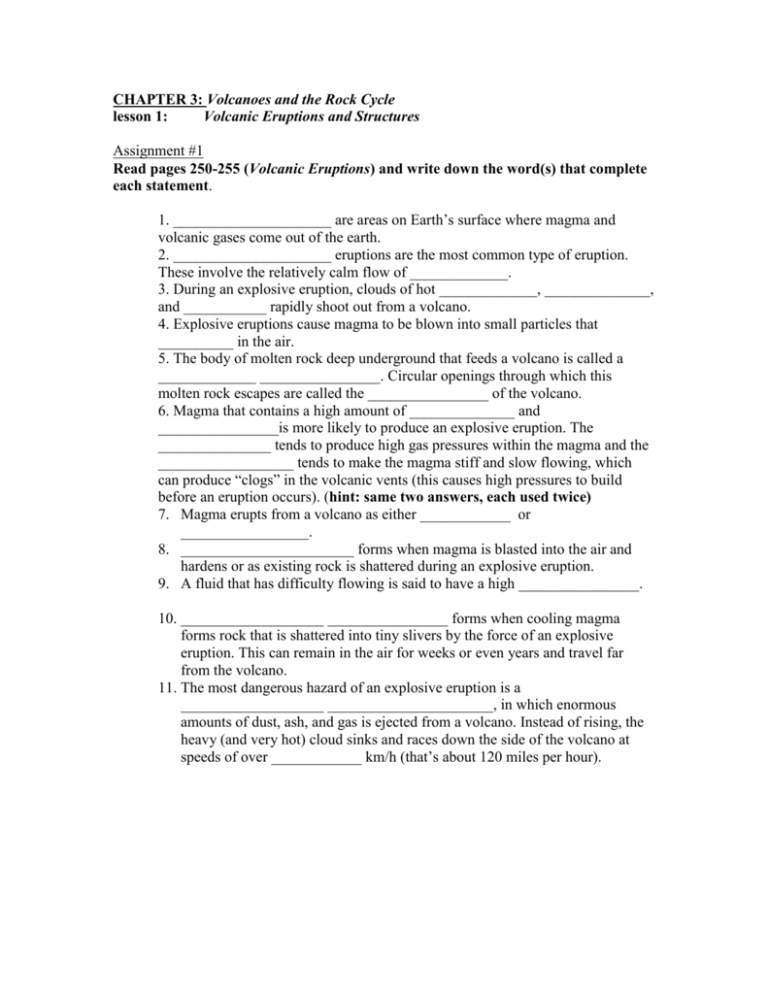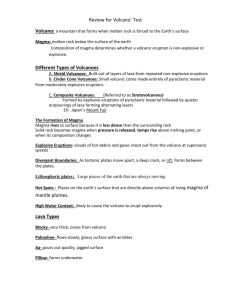UNIT 5: Earthquakes and Volcanoes
advertisement

CHAPTER 3: Volcanoes and the Rock Cycle lesson 1: Volcanic Eruptions and Structures Assignment #1 Read pages 250-255 (Volcanic Eruptions) and write down the word(s) that complete each statement. 1. _____________________ are areas on Earth’s surface where magma and volcanic gases come out of the earth. 2. _____________________ eruptions are the most common type of eruption. These involve the relatively calm flow of _____________. 3. During an explosive eruption, clouds of hot _____________, ______________, and ___________ rapidly shoot out from a volcano. 4. Explosive eruptions cause magma to be blown into small particles that __________ in the air. 5. The body of molten rock deep underground that feeds a volcano is called a _____________ ________________. Circular openings through which this molten rock escapes are called the ________________ of the volcano. 6. Magma that contains a high amount of ______________ and ________________is more likely to produce an explosive eruption. The _______________ tends to produce high gas pressures within the magma and the __________________ tends to make the magma stiff and slow flowing, which can produce “clogs” in the volcanic vents (this causes high pressures to build before an eruption occurs). (hint: same two answers, each used twice) 7. Magma erupts from a volcano as either ____________ or _________________. 8. _______________________ forms when magma is blasted into the air and hardens or as existing rock is shattered during an explosive eruption. 9. A fluid that has difficulty flowing is said to have a high ________________. 10. ___________________ ________________ forms when cooling magma forms rock that is shattered into tiny slivers by the force of an explosive eruption. This can remain in the air for weeks or even years and travel far from the volcano. 11. The most dangerous hazard of an explosive eruption is a ___________________ ______________________, in which enormous amounts of dust, ash, and gas is ejected from a volcano. Instead of rising, the heavy (and very hot) cloud sinks and races down the side of the volcano at speeds of over ____________ km/h (that’s about 120 miles per hour). Assignment #2 Read chapter 9, pages 256-258 (Effects of Volcanic Eruptions). 1. During large-scale eruptions, large amounts of dust and ash are ejected into the upper atmosphere. Ash and dust in the atmosphere causes some of the incoming ____________________ to be blocked, causing global __________________ to drop. 2. The climate change caused by some volcanic eruptions can affect people by causing _______________ shortages in parts of the world. 3-9. Matching: Choices: Shield volcano (S) Cinder Cone volcano (CC) Composite Volcano (COMP) 3. These commonly occur in clusters on the sides of other volcanoes. _________ 4. These are built of layers of lava released by repeated nonexplosive eruptions. ___ 5. These are formed of mainly pyroclastic material from repeated moderately explosive eruptions. ___________ 6. These are sometimes called “stratovolcanoes” because they can grow to enormous heights above sea level. ___________ 7. These form broad mountains with gently sloping sides. ___________ 8. These form from explosive eruptions of pyroclastic material followed by quieter flows of lava. They have broad bases that get steeper toward the top. _________ 9. These usually erode quickly because the pyroclastic material is not cemented together. ___________ End Matching 10. Around the central vent of many volcanoes is a funnel-shaped pit called a _________________. They form when magma remaining in the vent following an eruption ______________ back underground. 11. In the case of shield volcanoes, the magma chambers are shallow. If the chamber partially empties (as the result of a large eruption of decrease in magma supply from the mantle), the entire top of the mountain may collapse downward, producing a _______________________. These are similar to craters but many times _____________________. Assignment #3 Read pages 260-267 (Causes of Volcanic Eruptions) 1. Magma forms in many places along divergent boundaries due to a decrease in ________________ acting on the mantle rock. The magma comes from the mantle and is low in silica. Eruptions here tend to be ___________________ in type. 2. Magma forms over hot spots due to an increase in ___________________ of the mantle rock. The magma comes from the mantle and is low in silica. Eruptions here tend to be ___________________ in type. 3. Magma forms over subduction zones due the release of __________________ from the subducting plate. This lowers the _____________________ _____________________ of the surrounding crustal rock, causing it to melt. 4. The magma that feeds “subduction zone volcanoes” comes from the crust, and is high in silica and water. This causes the eruptions to be ________________ in type. About _______________ % of volcanoes on land are this type. 5. Most of the world’s subduction zone volcanoes occur along the rim of the _________________ ocean. This area is known as the ____________________ __________ ______________. 6. About ___________ % of volcanoes on land form along divergent boundaries and about ___________ % form over hot spots. 7. Volcanoes are classified into categories based on their activity. ___________________ volcanoes have not erupted in recent history and probably will never erupt again. ______________________ volcanoes are currently erupting or show signs of erupting in the near future. ___________________ volcanoes are not currently erupting, but are expected to erupt again. 8. Most active volcanoes produce small ____________________ as magma within moves upward, causing rocks to shift. An increase in the _________________ and ___________________ of these can signal an upcoming eruption. 9. To monitor the activity of volcanoes, scientists study the volume and composition of ________________ __________________. The ratio of ___________________________ to ___________________________ is an important factor in predicting eruptions. An ___________________ in this ratio may indicate a future eruption. 10. Often, before a volcano erupts, its shape starts to _________________. An instrument called a _____________________ can measure changes in the slope of the mountain. 11. ____________________ satellite images of a volcano are monitored to study the _________________ near the surface of a volcano. If this increases, magma is moving upward toward the surface.







